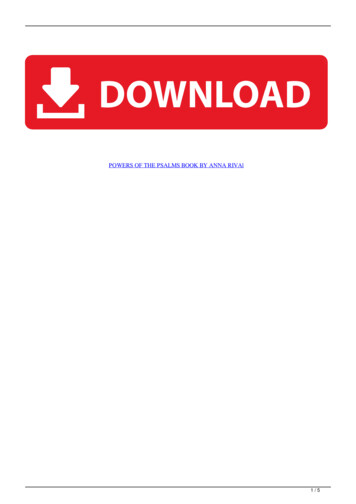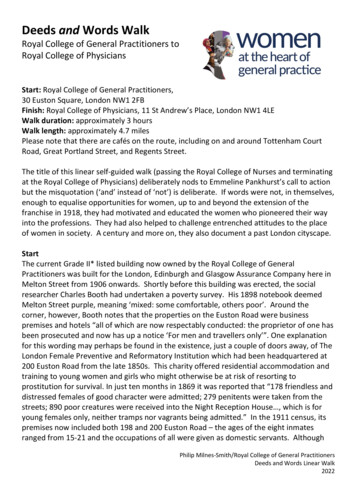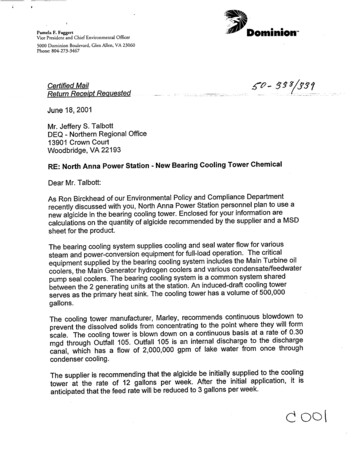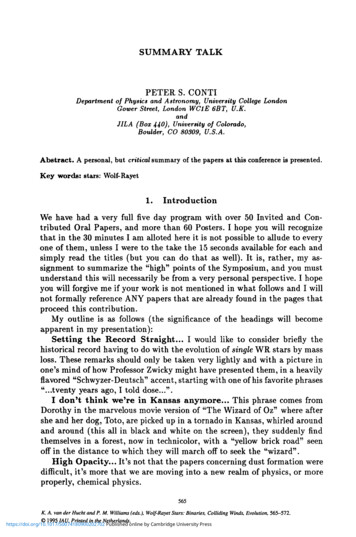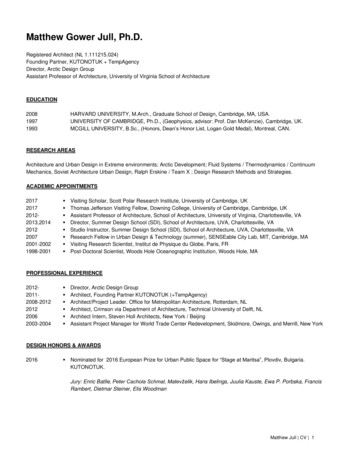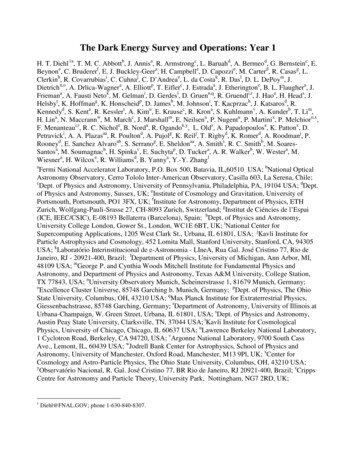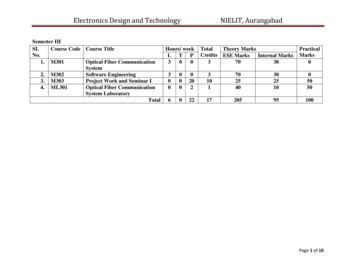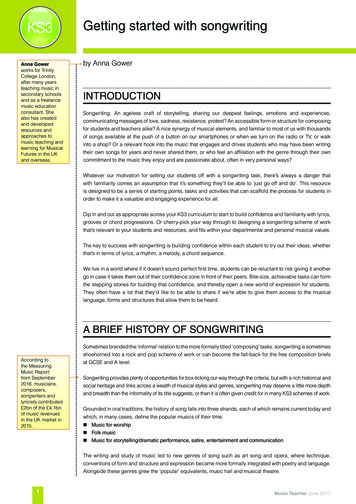
Transcription
KS35KSAnna Gowerworks for TrinityCollege London,after many yearsteaching music insecondary schoolsand as a freelancemusic educationconsultant. Shealso has createdand developedresources andapproaches tomusic teaching andlearning for MusicalFutures in the UKand overseas.Getting started with songwritingby Anna GowerINTRODUCTIONSongwriting. An ageless craft of storytelling, sharing our deepest feelings, emotions and experiences,communicating messages of love, sadness, resistance, protest? An accessible form or structure for composingfor students and teachers alike? A nice synergy of musical elements, and familiar to most of us with thousandsof songs available at the push of a button on our smartphones or when we turn on the radio or TV, or walkinto a shop? Or a relevant hook into the music that engages and drives students who may have been writingtheir own songs for years and never shared them, or who feel an affiliation with the genre through their owncommitment to the music they enjoy and are passionate about, often in very personal ways?Whatever our motivation for setting our students off with a songwriting task, there’s always a danger thatwith familiarity comes an assumption that it’s something they’ll be able to ‘just go off and do’. This resourceis designed to be a series of starting points, tasks and activities that can scaffold the process for students inorder to make it a valuable and engaging experience for all.Dip in and out as appropriate across your KS3 curriculum to start to build confidence and familiarity with lyrics,grooves or chord progressions. Or cherry-pick your way through to designing a songwriting scheme of workthat’s relevant to your students and resources, and fits within your departmental and personal musical values.The key to success with songwriting is building confidence within each student to try out their ideas, whetherthat’s in terms of lyrics, a rhythm, a melody, a chord sequence.We live in a world where if it doesn’t sound perfect first time, students can be reluctant to risk giving it anothergo in case it takes them out of their confidence zone in front of their peers. Bite-size, achievable tasks can formthe stepping stones for building that confidence, and thereby open a new world of expression for students.They often have a lot that they’d like to be able to share if we’re able to give them access to the musicallanguage, forms and structures that allow them to be heard.A BRIEF HISTORY OF SONGWRITINGSometimes branded the ‘informal’ relation to the more formally titled ‘composing’ tasks, songwriting is sometimesAccording tothe MeasuringMusic Reportfrom September2016, musicians,composers,songwriters andlyricists contributed 2bn of the 4.1bnof music revenuesin the UK market in2015.shoehorned into a rock and pop scheme of work or can become the fall-back for the free composition briefsat GCSE and A level.Songwriting provides plenty of opportunities for box-ticking our way through the criteria, but with a rich historical andsocial heritage and links across a wealth of musical styles and genres, songwriting may deserve a little more depthand breadth than the informality of its title suggests, or than it is often given credit for in many KS3 schemes of work.Grounded in oral traditions, the history of song falls into three strands, each of which remains current today andwhich, in many cases, define the popular musics of their time: Music for worship Folk music Music for storytelling/dramatic performance, satire, entertainment and communicationThe writing and study of music led to new genres of song such as art song and opera, where technique,conventions of form and structure and expression became more formally integrated with poetry and language.Alongside these genres grew the ‘popular’ equivalents, music hall and musical theatre.1Music Teacher June 2017
As music became more accessible to everyone through the development of recorded sound and technologies,new sounds and experiences were opened up by new musical instruments, new ways to duplicate and sharemusic, and more opportunities for travel. The results were new genres within what we now define as popularmusic, which exploded in the 20th century and was developed and nurtured by artists intent on finding newways to express the stories they had to tell through the songs that they wrote and recorded.The image below shows just a few of the many grooves and styles that constitute what we commonly labelas ‘popular music’. With increased access to music technology through apps, tablets and smartphones, aswell as better platforms for sharing and hearing new music across a huge variety of styles, the term ‘fusions’is often used to describe the new sounds generated when styles are mixed together. As technology becomeseven more accessible, anyone can become the owner and creator of new music with just the touch of a button.PROGRESSION TO GCSEAreas of study based around popular music, under which songwriting sits most comfortably, feature in all thecurrent GCSE specifications and form an important part of vocational qualifications such a BTEC and RSLAccess to Music. In addition, all of the exam boards allow candidates to compose to a brief of their choice,and songwriting is often a popular choice since the genre is very familiar to students.With the introduction of the new specifications in England and an increased emphasis on access to the highestgrades for all students, preparation for music beyond the point at which it is statutory has become a priorityfor many teachers at KS3.Compositions across the exam specs are assessed on some or all of the following: Stylistic coherence Development of ideas Technical control Musical coherence Expressive control/creativityMusic Teacher June 20172
In addition, here’s a breakdown of related content by exam board:BoardPopular music contentAQAPopular music: students must be able to identify and accurately describe musicalelements, musical contexts and musical language in these areas (covered in its ownMusic Teacher resource, September 2016):yy Music of Broadway 1950s to 1990syy Rock music of 1960s and 1970syy Film and computer gaming music 1990s to presentyy Pop music 1990s to presentStudy piece: The Beatles’ Sgt Pepper’s Lonely Hearts Club Band (covered in its ownMusic Teacher resource, February 2017):yy ‘With a Little Help from My Friends’yy ‘Within You Without You’yy ‘Lucy in the Sky with Diamonds’EduqasPopular music: in this area of study, learners will develop an understanding of popularmusic: rock and pop, bhangra and fusion (of different styles).Through listening to and/or performing examples of popular music, learners learn aboutinstrumental sounds, techniques and explore a list of related stylistic features providedby the exam board.Study piece: Rainbow’s ‘Since You’ve Been Gone’WJECPopular music: in this area of study, learners will develop an understanding of popularmusic – rock and fusion (of different styles). Learners are encouraged to explore themusic of Welsh bands and solo performers in this area of study.Through listening to and/or performing examples of popular music, learners learn aboutinstrumental sounds, techniques and explore a list of related stylistic features providedby the exam board.Study piece: Stereophonics’ ‘Handbags and Gladrags’EdexcelNo specific popular music content, although wider listening in the Fusions area of studycould include it.OCRLearners should study a range of popular music from the 1950s to the present day(covered in its own Music Teacher resource, March 2017), focusing on:yy Rock ‘n’ roll: 1950s and 1960syy Rock anthems: 1970s and 1980syy Pop ballads: 1970s, 1980s and 1990syy Solo artists: 1990 to the present dayGETTING STARTED WITH SONGWRITINGThere is no one right way to start writing a song. Depending on musical experience, comfort zone, confidenceand skills, students may engage better with one approach than another. It’s great to explore a series of startingpoints so they start to amass some tools and ideas before they start to feel ready to pull them together intoone final song.Why write a song anyway?Encouraging students to use songwriting to tell a story, as a form of expression, or to communicate somethingthat is important to them can make the process more meaningful – and hopefully result in better-qualityoutcomes.A great way into this is to share favourite songs and try to say why they are favourites. It’s something thatstudents do informally all the time as they share their playlists with friends, although they may find it moredifficult to articulate why they like one song more than another.3Music Teacher June 2017
Is it the melody that you can’t help but sing along to? A particular hook or riff that has become a favourite thateveryone recognises? Lyrics that resonate or rhyme in a way that makes them catchy and memorable? Orsimply a song that’s everywhere, so that you can’t help but get to know and love it?Understanding why some songs are more successful than others is something students often don’t give muchthought to. However, justifying musical choices and giving thought to their own personal preferences are stepstowards being able to identify, compare and evaluate elements of music that they hear, whether familiar or not.Throughout the next section are a series of activities that could be a stepping stone into songwriting for yourstudents. These could be taught in any of the following ways, depending on the resources and instrumentsyou have available. Get inspired: use music that students are familiar with, or have chosen themselves, to increase confidence.These songs are a great source of ideas to copy and then develop, and to inspire students to want to writetheir own songs. Warm-ups, starters and tasters designed to build a musical toolkit of ideas, and to create an ethos that it’sokay to try an idea even if it doesn’t sound perfect first time through. Whole-class activities to model how to use the toolkit’s basic tools, and to start to create a piece of musiccollaboratively. Small-group tasks to consolidate whole-class learning. Independent learning: being ready for the challenges of composing individually at KS4 and KS5. Develop and differentiate-thinking about how access to the internet and music technology can supportstudents with songwriting.THE BUILDING BLOCKS OF SONGWRITINGThe activities below explore different ways to get started with songwriting, which can include: Finding something to say: exploring what inspires us to write a song, and how that can impact on themusical decisions that form part of the songwriting process. Lyrics: for many students who may lack experience to begin from a musical starting point, lyrics are a greatfirst step. Grooves: basing a song in a certain style or building on a groove is a great way to scaffold to songwriting.Music technology can make creating a groove much simpler. Students can then use their voices to rap orsing as they learn how to make their lyrics fit to their chosen groove or style. Chords: starting with a simple two- or four-chord sequence is a great way to model how you start to buildmusical foundations for songwriting as a whole class. Learning to play a chord series on instrumentstogether gives students the tools they need to then go off into groups and explore how they might developthese further. Hooks and riffs: starting with short repetitive melodic patterns requires students to be creative with smalleramounts of musical material. Use of music technology in the form of loopers, apps or sequencing softwarecan enable students to build layers of sound quickly and easily with even the most basic instrumental skills. Melody: extending hooks and riffs through techniques including call and response, adding and repeatingnotes, or singing the words with the natural rise and fall of the language. This requires some confidence,which can be built through whole-class singing and workshopping activities. Form and structure: looking at song structure and aiming to compose verses, choruses and a bridgesection allows for exploration of modulation, musical development and texture.Music Teacher June 20174
Related key natoCall andresponseScalesPentatonicUnisonA capellaScatConjunctDisjunctImprovisationWalking bassRootStepwiseDescendingSTRUCTURING YOUR SONGThe most common song structure is us-(Chorus)Key terminology Verse: usually the same music with different lyrics. The verse is often the part of the song where the mainelements of the ‘story’ are told. Chorus: usually the same words with the same music. The chorus uses the most catchy lyrics and melodies,and is repetitive, often repeating either the title or the main message of the song. Bridge: new music and new lyrics. Often called the ‘break’ because it’s a break from the repetition of theverse and chorus ideas. This section could be in a contrasting key or tonality. Contrast can also be providedwith an instrumental solo, a key moment in the ‘story’, a change in tempo or texture.Checklist for musical developmentDevelopment of ideas for any repeated section can take place through: Building up or scaling down textures. Changing the way parts are played, for example broken chords or picking rather than strumming. Use of a more complex drum part with additional fills or use of silence. Addition of vocal or instrumental harmonies. Addition of a counter melody. Chords played in inversion. Use of 7th chords or substitution chords. Rubato or dynamic contrast added to support the story, or to add meaning to the words.5Music Teacher June 2017
USING THE ACTIVITIESThere are many different starting points for songwriitng, and there’s no right or wrong way to get started. Eachof the tasks below can be used as a stand-alone activity, or connected with others to create a lesson series.The activities can be used as tasters or warm-ups, modelled through a whole-class workshop, developedthrough small-group work, or used as bite-size starting points for individual compositions.Music technology can be used to support students in many ways, for example: Students can use apps to create their own backing tracks and to build their band without needing specificinstrumental skills, to hear how their ideas might sound if played live. Recording and logging ideas. Searching out help with chords, lyrics, ideas. Support for students who might find group work challenging.SONGWRITING ACTIVITIESFind something to sayA song should mean something to the person who writes it. Expressing emotions, telling a story, having anopinion, exploring a cause that’s important to you, or simply deciding what you want to say – any of thesefactors can define how the elements of the song develop and come together.GET INSPIRED Come up with a title. Take a newspaper headline. Pick a line from a poem. Take a word or line from a book. Keep your ears open and note down any phrases that resonate with you during the day.ACTIVITY: GIVING YOUR SONG MEANING 1Sometimes the hardest thing about getting started is having too much choice. This taster activity requiresfocus, teamwork and quick thinking: As a homework task or starter, work through the starting points above so that every student has either atitle or a line of text. In small groups, share these and choose one to be the focus of this quickfire task. Students have ten minutes to create a 30-second piece based around their chosen words or phrase. Theycan sing, rap or play, but can use no more than ten words in total. The final piece must make sense. Theycan produce a slogan, jingle, motif or pattern. Perform the pieces and discuss how each group built on their starting point. Look at whether groups chose to develop their idea through extending lyrics, creating a hook or riff, oradding chords. Point out that once students have an initial idea, there are many ways into the next stage ofdeveloping their songs.ACTIVITY: GIVING YOUR SONG MEANING 2 As a homework task or starter, work through the starting points above so that every student has either atitle or a line of text. In pairs, take it in turns to ask and answer questions that tease out the meaning behind the words they havechosen. These questions could be: What does it mean? Why did you choose those words? What happens next? Why and how does it happen? How does the story end? At the end of the task, allow students to share their stories with another group and make some notes to addto their theme or title.Music Teacher June 20176
Write your lyricsGET INSPIREDA parody is an imitation of a particular style or genre often exaggerated for comedic effect. There are plentyof examples on YouTube that you can share with students, such as this one. Just be careful to check that thesubject matter is appropriate!ACTIVITY: GIVE LYRICS A NEW MEANINGIn this task, students rewrite the lyrics to a song they know, changing the meaning of the words but not thestructure.You will need:1. Audio of a song of your (or their) choice that has a clear and simple rhyming structure.Little Kids Rock havedeveloped someexcellent resourcesthat supportstudents withvocal improvisingthrough rappingand rhyming. Checkout their hip-hopvocal resourcesand many moreideas for buildingstudent confidencewith words, rhymesand lyrics on theirteacher Jamzone.2. Access to a backing track of the same song without vocals.3. A printed copy of the song lyrics. In groups, students take a verse and chorus from the song and rewrite the lyrics, changing the meaning.They can decide on the new meaning themselves, or decide as a class – for example changing a song to beabout the weather, or about something topical or relevant to your school or community. They should stick to the original rhyming structure. It’s best if you can do this task in a single room so that you can keep the backing track playing as they try tomake their new words fit. Once the groups have performed, unpick what they needed to do and in what order to make the task work.Did they sort the rhyming words out first, then fill in the gaps? Or did they start with the story and adjust therhymes as they went along?ACTIVITY: MAKING LYRICS FITYou will need:Find backing tracksat Wikiloops, a freelibrary in differentstyles. Or you couldmake your own, oreven just use therhythm demos on akeyboard!1. A backing track in a hip-hop style.2. An unrelated set of lyricsIn groups, set students the challenge of making the lyrics fit to the backing track. They can repeat or leave outwords, layer sounds or even create a melodic hook to give the piece some structure. Unpick the process anduse examples from the performances to show how the natural rhythms of the words, a sense of pulse and beat,and the confidence to improvise are all important parts of making lyrics fit.ACTIVITY: FREE WRITEThere are many lyricgenerator websitessuch as SongLyrics Generatorthat can supportstudents who arereally strugglingwith words. Bewareof rap lyricsgenerators as theytend to be filledwith ‘authentic’ (andtherefore hugelyinappropriate)language!As a class, write some lyrics together to model how to create lyrics that have meaning and fit with a pulse orbeat. Students can then go off into groups to extend those lyrics into a chorus for their song, using learningfrom the previous tasks.Get your groove onGET INSPIREDUnderstanding basic grooves and beats is best done by unpicking music that students may be familiar with.Using body percussion, clapping or chair drumming, it’s pretty easy to break grooves down into parts andrebuild them as a class.ACTIVITY: EXPLORING GROOVES AND BEATS THROUGH PLAYINGThe following grids can easily be adapted to include note values, and once you have divided the group intoparts they can play along with a song to see how the groove fits, then create and perform their own. Addingthese to a looping app or creating a drum track on a sequencing platform can also be the start of creating agroove to become the backbone of a song.7Music Teacher June 2017
Rock beat:Hi-hat (clap)xxSnare (hit your knee)xxxxBass drum (tap your right foot)xBeat1xxxxx234Disco beat 1:Hi-hat (clap)xxSnare (hit your knee)xxBass drum (tap your right foot)xBeat1xxx234Disco beat 2:Hi-hat (clap)xSnare (hit your knee)xxxBass drum (tap your right foot)xBeat1xxx234Exploring grooves in this way helps to reinforce the concept of the bass/snare pattern that underpins many drumbeats, and helps students develop a sense of beat and pulse to support ensemble work and performance.ACTIVITY: STEAL A GROOVEWarm-up activities that take place to music are a great way for students to assimilate aspects of a musicalstyle, listening and copying as the music plays. Here’s a step-by-step guide to building a whole-class groovethat starts with an original song, then develops into a new groove on which to build a new piece of music.1. Put on a song – your choice or the students’, it doesn’t matter.2. Start with simple pulse activities, clapping or tapping until everyone has found and can maintain the pulsetogether and on their own.3. Build in some simple call-and-response patterns where you or one of your students model key rhythmsfrom the track.4. Work around the group and encourage students to improvise rhythms together one by one as the trackplays.5. Extend the rhythmic patterns using body or vocal percussion, and try to get three or four different partsgoing at the same time.6. Stop the track, keep the patterns going, and see what the groove has become.7. Add in some percussion instruments and use this groove as the basis of a whole-class composition.At this point, it’s good to decide on a key to bass your song around. This can be a whole-class decision, ortry out ideas as students suggest them. Decide on a tonality, major or minor then pick a key that is accessibleon the instruments you have available. For guitars go for E minor, although ukuleles may find A minor easier.8. Add vocal melodies to the patterns, to start to create hooks and riffs that become the basis of your melodies.9. Add some basslines on keyboard or bass guitar.10. Add some chords.11. Start to throw in some repeated lyrics.12. Build a piece of music around the ideas you have in the group, and see what you can make from it!Music Teacher June 20178
Pick a chord, any chordThere’s a huge amount of theory that underpins a chord sequence. Triads, keys, relationships, relative major/minor, root, inversion, modulation and more – there’s an immense amount to learn about harmony, and it cantake many years of theoretical study to fully understand.Or you can just play and experiment and explore.There are some great resources that support students with basic chord patterns. By far the best are these ‘jamcards’ created by Little Kids Rock.These are a visual aid for students that help them to play any chord on keyboard simply by lining up the rootof the chord with the corresponding key and then pressing the highlighted notes to create a triad. They thenmove onto chord progressions and melodies, and they make experimenting with chord patterns accessibleand immediate for students.Once students get the hang of chords, they are soon able to work out which chords sound good together. Assoon as you have a two-chord pattern, it’s pretty simple to expand it to four chords, then eight, then 16, andso on.GET INSPIREDAs with all the suggested activities, the best place to start with chord sequences is to play some. A classperformance of a song on classroom instruments instantly provides students with a range of tools for theirmusical toolkit. Learn a song, take the chords and rearrange them. As soon as you remove the lyrics, melodyand groove, a chord sequence becomes the bare bones of something new.The following is a chord sequence from a well-known song. Do you recognise it? Without the context providedby the rest of the song, it could be any part of any number of different songs:Verse: D G C Em, D (repeat as needed)Pre-chorus: C D C D Chorus: G C D Em (repeat as needed)Once students learn to play the basic chord sequence, they can the start to experiment with repeating chords,changing the rate of harmonic change from one chord per bar to more or fewer – all of which you can modeland support as a class before sending them off into groups to get creative.CONCLUSIONThere are many activities that provide students with the tools they need to achieve the confidence, skills andideas on which to build the foundations of songwriting. Writing the song and performing the song doesn’t haveto be the end of the project, however. Why not challenge students to find out how to copyright and protecttheir music, look at the implications of digital downloads, royalties, rights and ownership? Hold a songwritingcompetition where others vote for their favourite songs. Above all, allow students to perform their songs liveso that they are able to see the entire journey through from that tiny spark of an idea to a complete song thatcommunicates something to everyone who hears it.9Music Teacher June 2017
grooves or chord progressions. Or cherry-pick your way through to designing a songwriting scheme of work that's relevant to your students and resources, and fits within your departmental and personal musical values. . songwriters and lyricists contributed 2bn of the 4.1bn of music revenues in the UK market in 2015. Music Teacher June 2017 2

